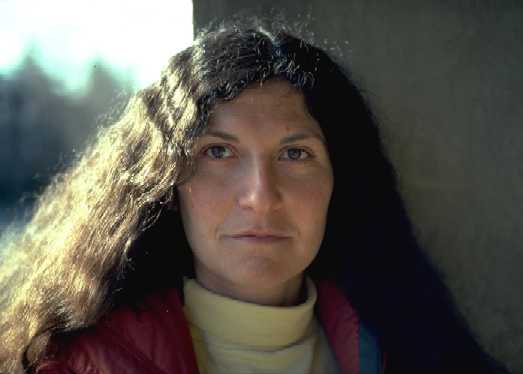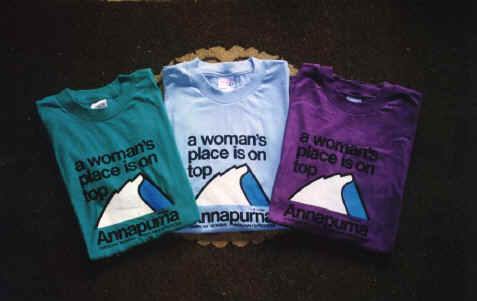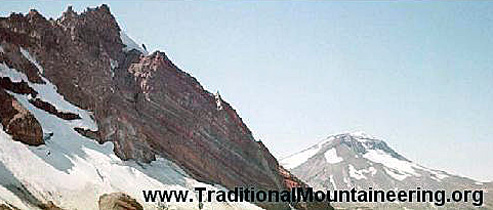TRADITIONAL MOUNTAINEERING
™
www.TraditionalMountaineering.org
™ and also
www.AlpineMountaineering.org
™
 ™
™
FREE BASIC TO ADVANCED
ALPINE MOUNTAIN CLIMBING INSTRUCTION™
Home
| Information
| Photos
| Calendar
| News
| Seminars
| Experiences
| Questions
| Updates
| Books
| Conditions
| Links
| Search

 Search this site!
Search this site!
Read more:
Annapurna, a woman's place is on top!

Out of Thick Air
Mountaineer Arlene Blum on the cathartic effect of climbing 26,000 feet
by
Sam Whiting
Sunday, March 30, 2003
Annapurna: A Woman's Place," tells how Arlene Blum led the first female
expedition up the world's 10th highest peak. It has taken her the 25 years since
then to figure out
the why.
Her just-completed second book is being shopped around this month. It shouldn't
have trouble finding a publisher, because "Annapurna" has become a classic among
climbers, with a 20th anniversary edition and a ranking as one of National
Geographic Adventure's "Top 100 Adventure Books of All Time."
Blum, 57, and her teenage daughter live in a house that hangs off Grizzly Peak
in Berkeley, on a street named Olympus, appropriately enough.
On inspiration for the new book.
It seems a little bizarre for a cautious woman from the Midwest who is out of
shape, overweight, not very adventurous, to end up leading all these
expeditions.
I don't ride my bike on roads because it's too dangerous. But in the course of
my life I've led a number of expeditions to 8,000-meter peaks (26,000 feet), and
these are the kinds of places where 1 out of 10 people dies. That's a pretty
high-risk activity. And I continued doing it for years.
I was trying to figure out what in my background led me to do this.
On the answer.
I was raised by very overprotective grandparents in the Midwest. They all
smoked. My grandma watched TV at full volume in this very small place. I would
go out into the
freezing cold winter with no coat and shovel snow, the whole block. It would be
such a relief just to escape my family and the cigarette smoke and the TV. So
being high on
a glaciated mountain in a blizzard was familiar to me from an early age. That
was a place of safety. Does that make sense?
On breaking away.
I was lucky to go to Reed College in Portland in the 1960s, because nobody
suggested there that girls weren't supposed to do things like be mountain
climbers or chemists.
On becoming a mountaineer.
My chemistry lab partner suggested that we go climb a mountain, and he was
handsome, so I said "sure." I'd never done anything physical my whole life. My
first few
climbs, I was catastrophically bad and uniquely incompetent. But the first time
I got on a glacier, I had this instant recognition that this was the most
beautiful, peaceful,
happy place I'd ever been.
On pursuing glaciers.
I was the first American woman to try to climb Everest. That was in 1976. I
wasn't considered the strongest climber, and only the strongest got to the top.
That was before the idea of getting a woman to the top of Everest seemed
interesting. The first American woman didn't get to the top of Everest until the
1990s, nearly 20
years later.
On putting off her thesis.
I went and saw the surfing movie "The Endless Summer" and decided I wanted to do
my own version "The Endless Winter." We did a lot of high mountains in Africa,
Afghanistan. At that time, in the early '70s, all the 8,000-meter peaks had been
climbed by men and none by women. We came up with the idea of doing an
international
all-women's expedition to climb the 10th highest peak.
On getting on the tenure track.
I became an acting professor at Stanford. I taught human biology there, and then
I taught at Wellesley and then back at Berkeley, where I taught in the biochem
department.
On getting off the tenure track.
In 1980 I decided to take a whole year off and walk across the Himalayas. It was
about 2,000 miles, but it's the up and down that is the tough part. The ridges
can be at
19,000 feet and the rivers at zero feet, and you're constantly going river to
ridge, river to ridge. It was the best year of my life. So I gave up my job. I
ended up never going
back to chemistry and just did adventures.
On vacationing at Everest.
I do some guiding, but I don't believe in guiding people who don't have the
ability to make their own life-and-death decisions. On the trip in [Jon
Krakauer' s] "Into Thin Air," the guides had problems, and the people were not
prepared to take responsibility.
On bringing the Himalayas to Berkeley.
When I came back from walking across the Himalayas for a year, I wanted to share
the experience. At the time I was teaching a class about trekking in the
Himalayas here at Berkeley, and I had 300 students in my class and we put on the
first Himalayan Fair in Live Oak Park in North Berkeley, in 1983. This is the
20th anniversary, the third weekend in May.
On making a living.
Writing and all these other things don't support me. I teach leadership classes
and intercultural classes.
©2004 San Francisco Chronicle


The sale of these
classic T-shirts raised over $80,000 to
help finance the
1978 first American ascent of Annapurna I in Nepal.

Read more . . .
Arlene Blum's personal website
Climbing Mount Hood in April with Arlene Blum and friends
 The Sport of Alpine Mountaineering
The Sport of Alpine Mountaineering
 Climbing Together
Climbing Together
 Following the Leader
Following the Leader
 The Mountaineer's Rope
The Mountaineer's Rope
 Basic Responsibilities
Basic Responsibilities
 The Ten Essentials
The Ten Essentials
 ™
™

 ™
™ ™
™![]()


![]()
The Sport of Alpine Mountaineering
Climbing Together
Following the Leader
The Mountaineer's Rope
Basic Responsibilities
The Ten Essentials
 ™
™